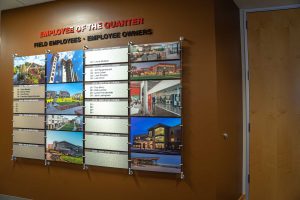Interior signs are a great way to provide both information and creativity to your space. Not only do they help guide customers, but they also help to create a brand identity and flow within your space. With the right font, size, color, and placement, interior signs can be used to create an environment that is both informative and creative.
Signage Should be an Extension of Your Brand

We help incorporate the essence of your brand and create design cohesion for a complete sign strategy.
When designing interior signage, it’s important to consider how the sign will represent your business or brand. Your signage should be a representation of the identity you have cultivated for your brand. This includes considering the typeface, font size, color scheme, and other elements that make up the design.
Think about the kinds of messages you want to convey to your customers and how your signage can help achieve that. Consider incorporating elements from your logo, such as color and fonts, to create a seamless connection between your branding and signage. If you have any unique visual elements associated with your brand, consider using them in your interior signage design.
Consider the Viewer’s Perspective
When designing interior signs, it’s important to consider the perspective of the viewer. It’s easy to get caught up in making something eye-catching and forget about how it will be seen. Think about how people will be viewing your sign when they walk into the room or pass by it. What kind of impact do you want to make? Will your message be easy to read from a distance? Will people be able to easily find their way around with the help of your sign?
The size of the font should be large enough for viewers to read from a few feet away. Font selection is also important; consider picking a font that is both readable and eye-catching. Choose colors that are clear and bold. These will stand out more and make sure that your sign isn’t overlooked.
Placement of your sign is key; the location should be in an area where it can easily be seen. Is it located near an entrance or exit point? Does it have a good view of the room or hallway it’s in? You can also use other signage to create a guide and direct customers to your sign.
The most important thing to remember is that signs should always be informative, but they can also be creative. By considering the viewer’s perspective and designing with purpose, you can create signs that are both useful and visually appealing.
Different Types of Interior Signs
There are a variety of types of signs that can be used to help customers find their way and communicate important information. Here’s a look at some of the different types of interior signs and how they can be used:
- Multi-dimensional Signage: Multi-dimensional signage uses both visual elements, like text and images, as well as physical elements, like raised letters and textures. These types of signs can be used to provide direction, create branded environments, or simply add a unique touch.
- Wall Murals: Wall murals are an eye-catching way to make a statement in any space. They can include your brand logo or imagery, key words, and a message that encapsulates the feeling you want to evoke.
- ADA Signs: ADA signs are designed to comply with the Americans with Disabilities Act (ADA) and provide accessible signage for all people. These types of signs include tactile elements, such as braille and raised letters, as well as audible instructions for those with vision impairment.
- Wayfinding Signs: Wayfinding signs are essential for helping people find their way around a space. These types of signs often include arrows and other symbols to indicate direction. They should also be placed strategically so that customers are guided from one area to the next.
- Window Graphics: Window graphics can be used to communicate information about your business, such as hours of operation or featured products and services. They can also be used to display art, providing an aesthetically pleasing design element in any space.
Interior signs are an important part of creating a cohesive and functional space. By utilizing the right type of sign for each purpose, you can ensure that your brand identity is conveyed and that customers can navigate your space with ease.




